2011年12月31日
A Success Story
A year ago, I wrote about the redevelopment of Takamatsu's Central Shopping Mall (see http://cathy.ashita-sanuki.jp/d2010-12.html and http://cathy.ashita-sanuki.jp/e382325.html ). Recently I stumbled across a city brochure claiming that this project was gaining international attention as a successful example of how to revitalize a city center. At first, I failed to take these words very seriously but when my daughter, who is majoring in economics, told me that it was presented as an example during a course on economic geography at her university in Tokyo, I became intrigued.
What were the factors cited in this success? The first was ensuring steady local clientele by building housing right into the shopping mall. I went down to take a better look and, sure enough, there they were: new apartment buildings rising out of the shopping mall below.

But they weren't visible at all from inside the shopping arcade.


Set back so as not to overshadow the street, they are only noticeable if you happen to be looking up as you cross an intersection.
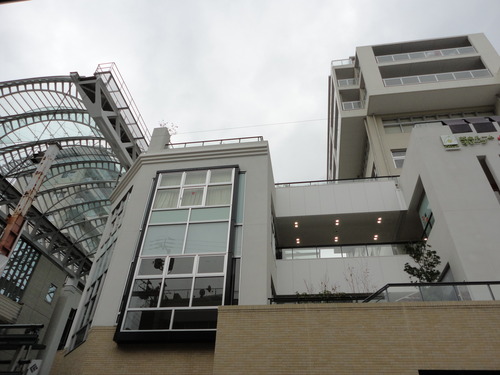
A quick search on line revealed that the apartments in Marugame-machi G-block, the last section which is currently under construction, are already sold out. I guess that's an indication that their plan is succeeding.
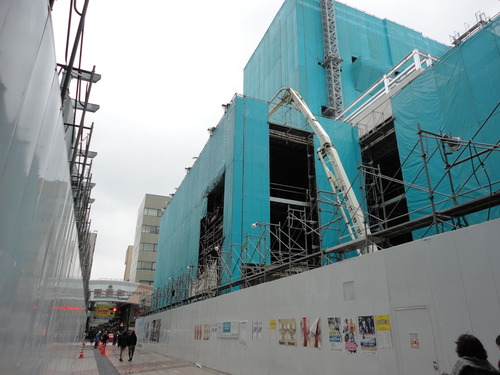
Another factor in the project's success is zoning. As far as I can understand it, there are 7 blocks from A to G, starting with Mitsukoshi department store at the north end and ending at Route 11 on the south. The north end is dedicated to high-end brand fashion shops like Gucci and Gap combined with slightly pricier restaurants. There are, however, a few less expensive ones, like this dollar shop

and this 'natural' food store that has a cafeteria selling set lunches for under 1,000 yen.

Moving south, the shops are less high-end and more practical. There are some interesting idea shops like the one below. Called Machi no Shure, it's a second floor establishment that includes many individual shops, a popular restaurant with homebaked bread, a small gallery featuring local artists and others, and outlets for local products. The fact that they sold Isamu Noguchi Akari lamps was a nice surprise.
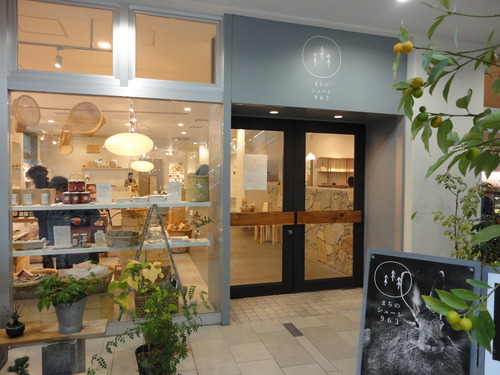
The final key cited for the project's success was an attractive design and it is certainly much more interesting than the designs seen in an average shopping mall. The street itself is light and airy thanks to the high transparent roof

and many of the roads are decorated with mosaics.

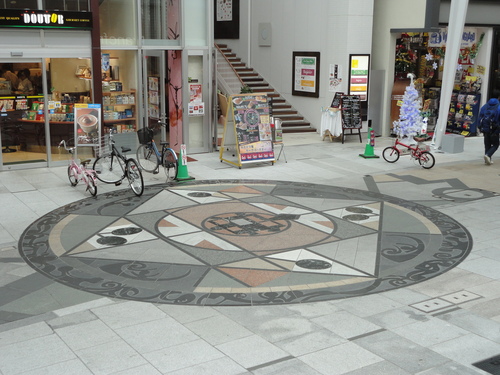
Many of the original shops have survived with only minor renovations, such as the Buddhist altar store below

and this tea shop.

In addition, some vintage touches have been left alone, conserving the distinctive flavor of Takamatsu's original shopping streets, like this clock.

All in all, even after the reconstruction, the area remains fun and interesting. Finally, it was encouraging to see that pilgrims doing the Shikoku 88-temple route still feel welcome here despite the transformation, proof I hope that the city still retains its soul.

What were the factors cited in this success? The first was ensuring steady local clientele by building housing right into the shopping mall. I went down to take a better look and, sure enough, there they were: new apartment buildings rising out of the shopping mall below.
But they weren't visible at all from inside the shopping arcade.
Set back so as not to overshadow the street, they are only noticeable if you happen to be looking up as you cross an intersection.
A quick search on line revealed that the apartments in Marugame-machi G-block, the last section which is currently under construction, are already sold out. I guess that's an indication that their plan is succeeding.
Another factor in the project's success is zoning. As far as I can understand it, there are 7 blocks from A to G, starting with Mitsukoshi department store at the north end and ending at Route 11 on the south. The north end is dedicated to high-end brand fashion shops like Gucci and Gap combined with slightly pricier restaurants. There are, however, a few less expensive ones, like this dollar shop
and this 'natural' food store that has a cafeteria selling set lunches for under 1,000 yen.
Moving south, the shops are less high-end and more practical. There are some interesting idea shops like the one below. Called Machi no Shure, it's a second floor establishment that includes many individual shops, a popular restaurant with homebaked bread, a small gallery featuring local artists and others, and outlets for local products. The fact that they sold Isamu Noguchi Akari lamps was a nice surprise.
The final key cited for the project's success was an attractive design and it is certainly much more interesting than the designs seen in an average shopping mall. The street itself is light and airy thanks to the high transparent roof
and many of the roads are decorated with mosaics.
Many of the original shops have survived with only minor renovations, such as the Buddhist altar store below
and this tea shop.
In addition, some vintage touches have been left alone, conserving the distinctive flavor of Takamatsu's original shopping streets, like this clock.
All in all, even after the reconstruction, the area remains fun and interesting. Finally, it was encouraging to see that pilgrims doing the Shikoku 88-temple route still feel welcome here despite the transformation, proof I hope that the city still retains its soul.
Posted by cathy at
22:49
│Comments(2)
2011年12月31日
Saving History
Shikoku Mura Continued
Last article, I introduced one of my favorite spots in Takamatsu, Shikoku Mura, a picturesque open-air museum full of traditional buildings and implements.

I also inspired myself to get an annual pass so I can go hiking there whenever I want. And it is good hiking!

One fact that most foreign visitors never learn, and one of the many reasons I love this museum, is that it was started by a single individual, Tatsuo Katoh. In the 1970s, Katoh was president of Katolec, a global logistics and electronics company that originated in Kagawa. This was during the period of Japan’s rapid economic growth. Realizing that in the rush towards modernization, traditional architecture was quickly vanishing from the Shikoku region, Katoh began collecting buildings, as well as the stories and implements that went with them, such as these.

A winnower (I think!)

Squid traps

Fishing boat
He gathered them from remote places all over the island to leave to posterity. Katoh had the buildings painstakingly pieced back together again on site, with great care taken to recreate the natural setting and lifestyle. This is amply demonstrated by this toilet and bath, which ias a "Registrered Tangible Cultural Property".



And by this boar fence to keep wild boars from raiding farmers' fields which comes complete with a pit in which the boars were trapped and caught for dinner.


Of course, all these buildings need regular maintenance, too, much of it requiring skills that would otherwise have died out. Such as thatching:


As well as regular gardening!

Katoh further had Japanese architect Tadao Ando design a small art museum to house his personal collection. The museum includes pieces from such contemporary artists as Picasso, Monet and Renoir as well as ancient art from Japan, China and the Middle East.

Art museum in 2002, the year it opened.

At the entrance in 2011.
Katolec continues to support the operation of Shikoku Mura to "return the company's fruits to society" (from Katolec's website). This spirit of community service is reflected in the museum's recent decision to transplant a 3-century old house from Minamisanriku, Miyagi. The thatched building was part of the Miyagi sericulture trade and had been carefully preserved for generations by a family of silk farmers. During the earthquake and tsunami of March 11, 2011, however, it suffered severe damage and neither the family nor the local community could restore it. Shikoku Mura will provide a fitting home and good care.
This is the second time Shikokumura has rescued a building outside of Shikoku. After the Great Hanshin-Awaji earthquake in 1995, the museum relocated and restored this historic lighthouse keepers’ building.


I'll be looking forward to watching the latest transplant being reconstructed over the next few years.
Hours: April-October 8:30-17:00 November to March 8:30-16:30
Access: 10 min. walk north from Kotoden Yashima Station, 15 min. walk north from Yashima JR station
Admission: Adults 800 yen; High school students 500 yen; Junior high school students 400yen,
Elementary school students 300 yen; Kindergarden and under free (Annual passes: single 3,000 yen; pair 5,000 yen)
Shikoku Mura Art Museum (includes park admission fee): Adults, 1000 yen; High school students, 600 yen; Elementary and Junior high school students, 450 yen
Parking facilities: Free parking (capacity: 20 buses and 200 cars)
Wheelchair: Partial/limited access
Last article, I introduced one of my favorite spots in Takamatsu, Shikoku Mura, a picturesque open-air museum full of traditional buildings and implements.
I also inspired myself to get an annual pass so I can go hiking there whenever I want. And it is good hiking!
One fact that most foreign visitors never learn, and one of the many reasons I love this museum, is that it was started by a single individual, Tatsuo Katoh. In the 1970s, Katoh was president of Katolec, a global logistics and electronics company that originated in Kagawa. This was during the period of Japan’s rapid economic growth. Realizing that in the rush towards modernization, traditional architecture was quickly vanishing from the Shikoku region, Katoh began collecting buildings, as well as the stories and implements that went with them, such as these.
A winnower (I think!)
Squid traps
Fishing boat
He gathered them from remote places all over the island to leave to posterity. Katoh had the buildings painstakingly pieced back together again on site, with great care taken to recreate the natural setting and lifestyle. This is amply demonstrated by this toilet and bath, which ias a "Registrered Tangible Cultural Property".
And by this boar fence to keep wild boars from raiding farmers' fields which comes complete with a pit in which the boars were trapped and caught for dinner.
Of course, all these buildings need regular maintenance, too, much of it requiring skills that would otherwise have died out. Such as thatching:
As well as regular gardening!
Katoh further had Japanese architect Tadao Ando design a small art museum to house his personal collection. The museum includes pieces from such contemporary artists as Picasso, Monet and Renoir as well as ancient art from Japan, China and the Middle East.

Art museum in 2002, the year it opened.
At the entrance in 2011.
Katolec continues to support the operation of Shikoku Mura to "return the company's fruits to society" (from Katolec's website). This spirit of community service is reflected in the museum's recent decision to transplant a 3-century old house from Minamisanriku, Miyagi. The thatched building was part of the Miyagi sericulture trade and had been carefully preserved for generations by a family of silk farmers. During the earthquake and tsunami of March 11, 2011, however, it suffered severe damage and neither the family nor the local community could restore it. Shikoku Mura will provide a fitting home and good care.
This is the second time Shikokumura has rescued a building outside of Shikoku. After the Great Hanshin-Awaji earthquake in 1995, the museum relocated and restored this historic lighthouse keepers’ building.
I'll be looking forward to watching the latest transplant being reconstructed over the next few years.
Hours: April-October 8:30-17:00 November to March 8:30-16:30
Access: 10 min. walk north from Kotoden Yashima Station, 15 min. walk north from Yashima JR station
Admission: Adults 800 yen; High school students 500 yen; Junior high school students 400yen,
Elementary school students 300 yen; Kindergarden and under free (Annual passes: single 3,000 yen; pair 5,000 yen)
Shikoku Mura Art Museum (includes park admission fee): Adults, 1000 yen; High school students, 600 yen; Elementary and Junior high school students, 450 yen
Parking facilities: Free parking (capacity: 20 buses and 200 cars)
Wheelchair: Partial/limited access
Posted by cathy at
22:25
│Comments(0)
2011年12月20日
‘Art-full’ Dining Tokiwa Saryo
Here’s another gem hidden away in the central Takamatsu: Japanese restaurant Tokiwa Saryo.

Tokiwa Saryo Restaurant
Located just one street south of the Tokiwa-gai arcade, this restaurant is closely connected to the shopping district’s history. It was built in the early 1950s by Jukichi Mizobuchi, a prominent local producer involved in theater, movies and events. Mizobuchi had already built a theater nearby, stimulating the development of a shopping arcade in this area.

Entrance
Tokiwa Saryo started out as a very posh inn. The design was so elaborate that construction took 4 years to complete. The distinctive golden fish and blue tiles that topped the castle-like structure could be seen all the way from Takamatsu Station when it was first built and it numbered among its clientele many famous people from showbiz, commerce and politics.
Due to modern fire regulations, the top floors are no longer used as a hotel, but the bottom two floors have been converted into a spectacular restaurant replete with inner courtyard garden and pond.

Dining area viewed from the courtyard.
The restaurant serves Japanese style box lunches with a little bit of everything, or tempura and sashimi set lunches. Prices are very reasonable ranging from a little over 1,000 to 3,000 yen for lunch. The food is delicious but even if it were ordinary, I think the price is still worth it just for the décor.
After lunch, you can ask for permission to take a stroll through the courtyard and beyond.

Courtyard

Alcove

The garden

The bridge

Looking back towards the dining area
The most stunning part of this restaurant, however, is the hall down a corridor to the left after crossing the little red bridge. Built in imitation of the drawing room of Nijo Castle in Kyoto, the walls and ceiling of the hall are covered with lacquer works by Akashi Bokkei, a local lacquer craftsman of the time.

Wall mural – pine tree
Bokkei’s wall mural motif consists of pine, bamboo and plum blossoms, which are symbols of celebration and good fortune in Japan.

Plum blossoms
Butterflies weave among the pine and plum trees, one for each year of Mizobuchi’s life. He passed away before the work was completed.

Bamboo
The cabinet in the above photo was custom made to house what was, at the time, a very modern stereo and speaker complete with LP records.

Ceiling
If you do find this room, don’t forget to look up. The ceiling panels are also elaborate lacquer work and mimic those found in castles and temples.

Ceiling panel close up
And last but not least are the koi (carp), another auspicious symbol, made by yet another skilled local artist of that period, Hidari Kohkyo.

Koi
If you are with a large group, you can reserve this room for lunch or dinner. If you are not with a large group but want to see the room, ask for permission at the front desk. They will usually let you wander in and take pictures, as long as you are quiet and respectful (i.e. keep out of the way of restaurant staff and guests).
Directions: From the west side of Kotoden Kawaramachi Station head down the covered shopping arcade called Tokiwa-gai. Turn left at a side street with a green grocer’s on the near corner and a lantern high up on the wall on the far side. (See the photo below.) The lantern says “Tokiwa Saryo” on it in Japanese.
写真15
Turn left at this corner.
Tokiwa Saryo is at the corner of the next street on the right. There’s also a map (in Japanese) on the website below.
Times: Lunch 11:00 to 15:00
Dinner: 17:00 to 22:00 (prices are higher for dinner)
Tel: 087-861-5577
Website: http://www.trs1515.com/~saryou/inquiry/top.html
For a little more information in English on prices, etc., see:
http://www.frommers.com/destinations/takamatsu/D50552.html
Tokiwa Saryo Restaurant
Located just one street south of the Tokiwa-gai arcade, this restaurant is closely connected to the shopping district’s history. It was built in the early 1950s by Jukichi Mizobuchi, a prominent local producer involved in theater, movies and events. Mizobuchi had already built a theater nearby, stimulating the development of a shopping arcade in this area.
Entrance
Tokiwa Saryo started out as a very posh inn. The design was so elaborate that construction took 4 years to complete. The distinctive golden fish and blue tiles that topped the castle-like structure could be seen all the way from Takamatsu Station when it was first built and it numbered among its clientele many famous people from showbiz, commerce and politics.
Due to modern fire regulations, the top floors are no longer used as a hotel, but the bottom two floors have been converted into a spectacular restaurant replete with inner courtyard garden and pond.
Dining area viewed from the courtyard.
The restaurant serves Japanese style box lunches with a little bit of everything, or tempura and sashimi set lunches. Prices are very reasonable ranging from a little over 1,000 to 3,000 yen for lunch. The food is delicious but even if it were ordinary, I think the price is still worth it just for the décor.
After lunch, you can ask for permission to take a stroll through the courtyard and beyond.
Courtyard
Alcove
The garden
The bridge
Looking back towards the dining area
The most stunning part of this restaurant, however, is the hall down a corridor to the left after crossing the little red bridge. Built in imitation of the drawing room of Nijo Castle in Kyoto, the walls and ceiling of the hall are covered with lacquer works by Akashi Bokkei, a local lacquer craftsman of the time.
Wall mural – pine tree
Bokkei’s wall mural motif consists of pine, bamboo and plum blossoms, which are symbols of celebration and good fortune in Japan.
Plum blossoms
Butterflies weave among the pine and plum trees, one for each year of Mizobuchi’s life. He passed away before the work was completed.
Bamboo
The cabinet in the above photo was custom made to house what was, at the time, a very modern stereo and speaker complete with LP records.
Ceiling
If you do find this room, don’t forget to look up. The ceiling panels are also elaborate lacquer work and mimic those found in castles and temples.
Ceiling panel close up
And last but not least are the koi (carp), another auspicious symbol, made by yet another skilled local artist of that period, Hidari Kohkyo.
Koi
If you are with a large group, you can reserve this room for lunch or dinner. If you are not with a large group but want to see the room, ask for permission at the front desk. They will usually let you wander in and take pictures, as long as you are quiet and respectful (i.e. keep out of the way of restaurant staff and guests).
Directions: From the west side of Kotoden Kawaramachi Station head down the covered shopping arcade called Tokiwa-gai. Turn left at a side street with a green grocer’s on the near corner and a lantern high up on the wall on the far side. (See the photo below.) The lantern says “Tokiwa Saryo” on it in Japanese.
写真15
Turn left at this corner.
Tokiwa Saryo is at the corner of the next street on the right. There’s also a map (in Japanese) on the website below.
Times: Lunch 11:00 to 15:00
Dinner: 17:00 to 22:00 (prices are higher for dinner)
Tel: 087-861-5577
Website: http://www.trs1515.com/~saryou/inquiry/top.html
For a little more information in English on prices, etc., see:
http://www.frommers.com/destinations/takamatsu/D50552.html
2011年12月15日
Summing Up
Summing Up Art Setouchi
The Setouchi International Art Festival was supposed to end on October 31. And it did, but it proved so successful that the prefecture has decided to go ahead with the original plan of hosting another festival in three years.

Jumping for joy on Megijima
In addition, many of the sites that were to be shut down and dismantled are being kept open for a few more months. A total of 42 sites* will be open, at least on weekends. Extra ferries and island buses will also be kept running experimentally to see if there is enough local demand to make their continuation worthwhile.

Seagull Parking Lot, Takahito Kimura, Megijima
So just how successful was it? In June, the organizers anticipated the festival would attract about 300,000 visitors with an economic benefit of about 5 billion yen. In fact, however, the festival attracted over 938, 000 visitors with an economic benefit of close to 15 billion yen. Wow!!!

Happy travelers on Teshima
The biggest financial winners were probably the ferry companies. Ferries were filled to capacity even with extra sailings to keep up with demand. Ferries to Megijima and Ogijima islands, for example, had 2.4 times more passengers than usual, causing the company to scrap its plans for selling off one of its boats.

The Meon docking at Ogijima
Hotels near Takamatsu station enjoyed twice as many customers as usual and clientele expanded to include families, students and foreigners in addition to businessmen. Local and festival-related souvenir shops also did a brisk business.

Ogijima’s Soul by Jaume Plensa
Nothing is perfect however and a number of things need to be addressed before the next festival. For example, one of Art Setouchi’s greatest attractions was being forced to slow down to “island time”. Billed as an “art adventure”, exploring these out-of-the-way islands and ‘discovering’ art was really fun!! But once the word spread, the area was deluged with people.

Ferry line up at Inujima stretching off out of sight.
About 500,000 visitors descended on the festival in October alone, more than had come in the first 2 months combined! This stretched transportation, accommodation and art facilities to the limit. It was the hardworking volunteer staff, the islanders’ spirit of hospitality and the patience of visitors that carried the festival through this overload.

Helping each other out on Ogijima
While some locations reaped economic benefits from this huge influx of people, many local tourist attractions did not. For example, the number of visitors to my favorite Takamatsu spot, Ritsurin Garden, (see http://cathy.ashita-sanuki.jp/e229240.html ) dropped to 87% of the norm in August and to 63% in September, even though it’s very accessible. The festival seems to have caught many local organizations and businesses by surprise and they were too late to take advantage of the opportunity. If they are going to link up with the next festival, they need to be involved from the planning stage.
The real measure of the festival’s success, however, must be its impact on the islands and on us, a subject I will look at in my next article.
*Note:
The fact that many sites are still open has been very under-publicized. Fortunately, despite this, some people are going back, glad to be able to enjoy the remaining sites at their leisure. If you are visiting or live here, go and check them out.
Sites open through to the end of December 2010 are listed here (Japanese only):
http://setouchi-artfest.jp/images/uploads/misc/artworks_20101101_20101231r.pdf
Sites open January through to the end of March 2011 are listed here (Japanese only):
http://setouchi-artfest.jp/images/uploads/misc/artworks_20110101_20110131.pdf
* Many thanks to Kazumi, Hiroko, Reina, Kento and Pat for sharing photos for this and the next article.
The Setouchi International Art Festival was supposed to end on October 31. And it did, but it proved so successful that the prefecture has decided to go ahead with the original plan of hosting another festival in three years.
Jumping for joy on Megijima
In addition, many of the sites that were to be shut down and dismantled are being kept open for a few more months. A total of 42 sites* will be open, at least on weekends. Extra ferries and island buses will also be kept running experimentally to see if there is enough local demand to make their continuation worthwhile.
Seagull Parking Lot, Takahito Kimura, Megijima
So just how successful was it? In June, the organizers anticipated the festival would attract about 300,000 visitors with an economic benefit of about 5 billion yen. In fact, however, the festival attracted over 938, 000 visitors with an economic benefit of close to 15 billion yen. Wow!!!
Happy travelers on Teshima
The biggest financial winners were probably the ferry companies. Ferries were filled to capacity even with extra sailings to keep up with demand. Ferries to Megijima and Ogijima islands, for example, had 2.4 times more passengers than usual, causing the company to scrap its plans for selling off one of its boats.

The Meon docking at Ogijima
Hotels near Takamatsu station enjoyed twice as many customers as usual and clientele expanded to include families, students and foreigners in addition to businessmen. Local and festival-related souvenir shops also did a brisk business.
Ogijima’s Soul by Jaume Plensa
Nothing is perfect however and a number of things need to be addressed before the next festival. For example, one of Art Setouchi’s greatest attractions was being forced to slow down to “island time”. Billed as an “art adventure”, exploring these out-of-the-way islands and ‘discovering’ art was really fun!! But once the word spread, the area was deluged with people.

Ferry line up at Inujima stretching off out of sight.
About 500,000 visitors descended on the festival in October alone, more than had come in the first 2 months combined! This stretched transportation, accommodation and art facilities to the limit. It was the hardworking volunteer staff, the islanders’ spirit of hospitality and the patience of visitors that carried the festival through this overload.
Helping each other out on Ogijima
While some locations reaped economic benefits from this huge influx of people, many local tourist attractions did not. For example, the number of visitors to my favorite Takamatsu spot, Ritsurin Garden, (see http://cathy.ashita-sanuki.jp/e229240.html ) dropped to 87% of the norm in August and to 63% in September, even though it’s very accessible. The festival seems to have caught many local organizations and businesses by surprise and they were too late to take advantage of the opportunity. If they are going to link up with the next festival, they need to be involved from the planning stage.
The real measure of the festival’s success, however, must be its impact on the islands and on us, a subject I will look at in my next article.
*Note:
The fact that many sites are still open has been very under-publicized. Fortunately, despite this, some people are going back, glad to be able to enjoy the remaining sites at their leisure. If you are visiting or live here, go and check them out.
Sites open through to the end of December 2010 are listed here (Japanese only):
http://setouchi-artfest.jp/images/uploads/misc/artworks_20101101_20101231r.pdf
Sites open January through to the end of March 2011 are listed here (Japanese only):
http://setouchi-artfest.jp/images/uploads/misc/artworks_20110101_20110131.pdf
* Many thanks to Kazumi, Hiroko, Reina, Kento and Pat for sharing photos for this and the next article.
2011年12月10日
The Last Word
The Last Word On Setouchi Art Festival 2010
Curious about the festival’s impact on the islands and on people, I have been talking with local artists and friends involved in the festival as well as others like me who experienced it.

Seto Inland Sea
According to my sources, while many islanders warmly welcomed the visitors, they are now breathing a sigh of relief. The party is over and they are happy to return to the slower pace of “island time”.

Island time on Teshima
During the festival, particularly on weekends and through most of October, some villages were so crowded that local residents had difficulty just walking down the street to get home. And, unfortunately, some people left their garbage behind.
On the bright side, the islanders realized that people actually enjoyed coming to their islands. Left behind by mainstream society, their backwater villages are now on the brink of disappearing but the festival demonstrated that they do indeed have charm and potential. The question is where to go from here.
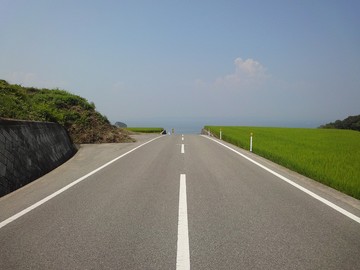
Teshima
If nothing else, Art Setouchi has forced those directly involved as well as those who just live here to ponder this very question. Further action, particularly by the islanders, is needed to explore the opportunities provided by the festival. Ideally, each island will develop their own style of collaboration with other people living in the prefecture as well as with artists – a collaboration that promotes sustainable action.

Lightening Shodoshima by Sense Art Studio
As a local and frequent visitor to the festival, I would have to say that it was nothing but positive. It gave me a chance to experience and appreciate the beauty of what we have. It also, as one friend aptly put it, served as a medium for people to make meaningful connections, with each other and with art and nature. What kept so many people going back? In their words…

Farther Memory by Chiharu Shiota
… art in architecture/architecture in art

Project by Aichi Prefectural University of Fine Arts and Music Team
… being able to walk right into an exhibit

House of Shodoshima by Wang Wen-Chih
and enjoy it like this

inside
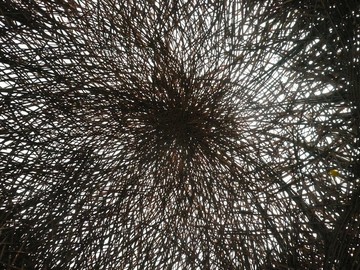
and out!
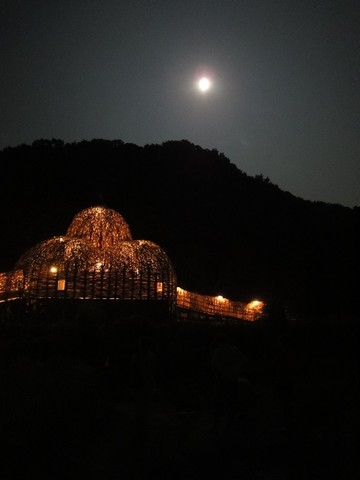
…art in nature/nature in art

When You Think of an Island by Rika Aki, Shodoshima
…having the time to listen
…to voices whispering through bamboo pipes

Voices from Disappeared People by Dadang Christanto, Shodoshima
…and seashells quivering by a spring.
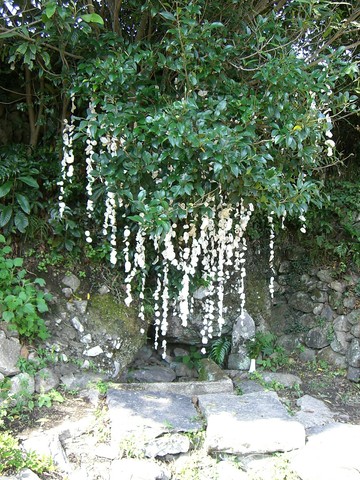
When You Think of an Island by Rika Aki, Shodoshima
… strange and wonderful encounters, such as walking through terraced rice fields in the middle of nowhere

and bumping into a friend from Tokyo.

Art within the ordinary made life extraordinary.

Hello Hachijuro by Hiroshi Fuji, Teshima
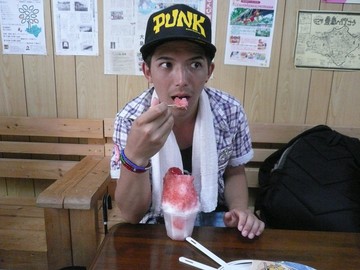
Ichigoya’s homemade strawberry sauce on ice, Teshima
And it was just so much fun!

For those of you who can, I hope you will consider going back to the islands on weekends and checking out the sites that are still open. The volunteers bravely manning the sites will be very glad to see you! If you don’t have a Japanese friend to read the schedules for you (See previous post), post a comment about where and when you want to go and I’ll let you know if it’s open.
For fans of Brazilian artist Oscar Oiwa
Oiwa Island, an amazing work drawn entirely with black magic markers and transformed into an endless landscape by mirrors, was sadly destroyed in a fire one month before the festival ended.
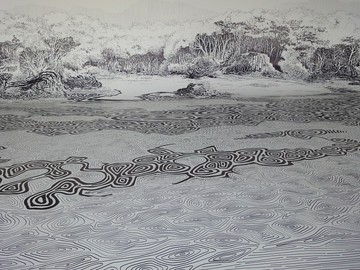
The work, however, has been awarded the festival’s grand prize. Many artists participated in the festival by invitation but some were chosen through a public screening process. Out of 721 entries, 20 artists were selected, and out of those, Oiwa’s Island won the prize. This grants the artist the right to participate in the next festival. We’ll look forward to seeing more of Oiwa’s work in Kagawa!
*Check out Oscar Oiwa’s site below to see a great video on the process of creating Oiwa’s Island.
http://www.oscaroiwastudio.com/oscar_website/pages.html/news.html
Video can also be accessed here: http://www.youtube.com/watch?v=zr59vzndrcU
Curious about the festival’s impact on the islands and on people, I have been talking with local artists and friends involved in the festival as well as others like me who experienced it.
Seto Inland Sea
According to my sources, while many islanders warmly welcomed the visitors, they are now breathing a sigh of relief. The party is over and they are happy to return to the slower pace of “island time”.
Island time on Teshima
During the festival, particularly on weekends and through most of October, some villages were so crowded that local residents had difficulty just walking down the street to get home. And, unfortunately, some people left their garbage behind.
On the bright side, the islanders realized that people actually enjoyed coming to their islands. Left behind by mainstream society, their backwater villages are now on the brink of disappearing but the festival demonstrated that they do indeed have charm and potential. The question is where to go from here.
Teshima
If nothing else, Art Setouchi has forced those directly involved as well as those who just live here to ponder this very question. Further action, particularly by the islanders, is needed to explore the opportunities provided by the festival. Ideally, each island will develop their own style of collaboration with other people living in the prefecture as well as with artists – a collaboration that promotes sustainable action.
Lightening Shodoshima by Sense Art Studio
As a local and frequent visitor to the festival, I would have to say that it was nothing but positive. It gave me a chance to experience and appreciate the beauty of what we have. It also, as one friend aptly put it, served as a medium for people to make meaningful connections, with each other and with art and nature. What kept so many people going back? In their words…
Farther Memory by Chiharu Shiota
… art in architecture/architecture in art
Project by Aichi Prefectural University of Fine Arts and Music Team
… being able to walk right into an exhibit
House of Shodoshima by Wang Wen-Chih
and enjoy it like this
inside
and out!
…art in nature/nature in art

When You Think of an Island by Rika Aki, Shodoshima
…having the time to listen
…to voices whispering through bamboo pipes
Voices from Disappeared People by Dadang Christanto, Shodoshima
…and seashells quivering by a spring.
When You Think of an Island by Rika Aki, Shodoshima
… strange and wonderful encounters, such as walking through terraced rice fields in the middle of nowhere
and bumping into a friend from Tokyo.
Art within the ordinary made life extraordinary.

Hello Hachijuro by Hiroshi Fuji, Teshima
Ichigoya’s homemade strawberry sauce on ice, Teshima
And it was just so much fun!
For those of you who can, I hope you will consider going back to the islands on weekends and checking out the sites that are still open. The volunteers bravely manning the sites will be very glad to see you! If you don’t have a Japanese friend to read the schedules for you (See previous post), post a comment about where and when you want to go and I’ll let you know if it’s open.
For fans of Brazilian artist Oscar Oiwa
Oiwa Island, an amazing work drawn entirely with black magic markers and transformed into an endless landscape by mirrors, was sadly destroyed in a fire one month before the festival ended.
The work, however, has been awarded the festival’s grand prize. Many artists participated in the festival by invitation but some were chosen through a public screening process. Out of 721 entries, 20 artists were selected, and out of those, Oiwa’s Island won the prize. This grants the artist the right to participate in the next festival. We’ll look forward to seeing more of Oiwa’s work in Kagawa!
*Check out Oscar Oiwa’s site below to see a great video on the process of creating Oiwa’s Island.
http://www.oscaroiwastudio.com/oscar_website/pages.html/news.html
Video can also be accessed here: http://www.youtube.com/watch?v=zr59vzndrcU



